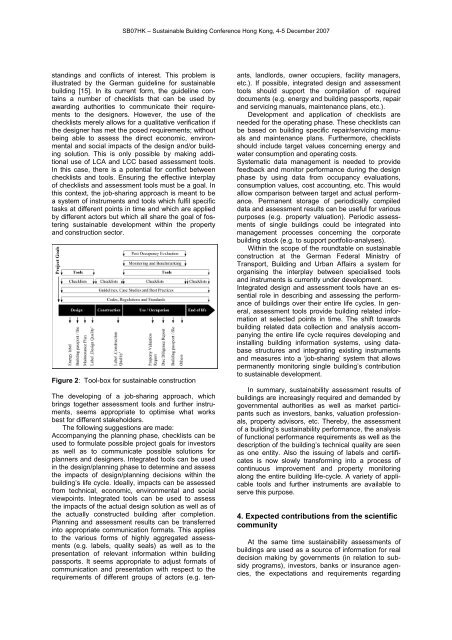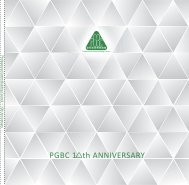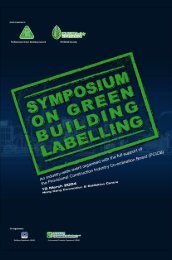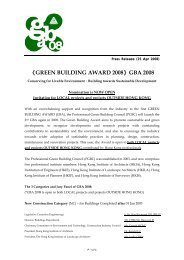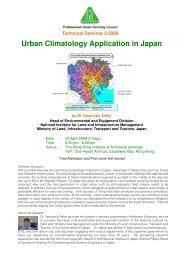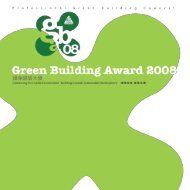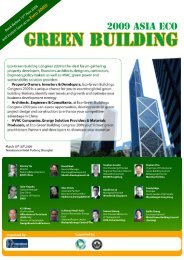Paper - The Professional Green Building Council
Paper - The Professional Green Building Council
Paper - The Professional Green Building Council
Create successful ePaper yourself
Turn your PDF publications into a flip-book with our unique Google optimized e-Paper software.
SB07HK – Sustainable <strong>Building</strong> Conference Hong Kong, 4-5 December 2007<br />
standings and conflicts of interest. This problem is<br />
illustrated by the German guideline for sustainable<br />
building [15]. In its current form, the guideline contains<br />
a number of checklists that can be used by<br />
awarding authorities to communicate their requirements<br />
to the designers. However, the use of the<br />
checklists merely allows for a qualitative verification if<br />
the designer has met the posed requirements; without<br />
being able to assess the direct economic, environmental<br />
and social impacts of the design and/or building<br />
solution. This is only possible by making additional<br />
use of LCA and LCC based assessment tools.<br />
In this case, there is a potential for conflict between<br />
checklists and tools. Ensuring the effective interplay<br />
of checklists and assessment tools must be a goal. In<br />
this context, the job-sharing approach is meant to be<br />
a system of instruments and tools which fulfil specific<br />
tasks at different points in time and which are applied<br />
by different actors but which all share the goal of fostering<br />
sustainable development within the property<br />
and construction sector.<br />
Figure 2: Tool-box for sustainable construction<br />
<strong>The</strong> developing of a job-sharing approach, which<br />
brings together assessment tools and further instruments,<br />
seems appropriate to optimise what works<br />
best for different stakeholders.<br />
<strong>The</strong> following suggestions are made:<br />
Accompanying the planning phase, checklists can be<br />
used to formulate possible project goals for investors<br />
as well as to communicate possible solutions for<br />
planners and designers. Integrated tools can be used<br />
in the design/planning phase to determine and assess<br />
the impacts of design/planning decisions within the<br />
building’s life cycle. Ideally, impacts can be assessed<br />
from technical, economic, environmental and social<br />
viewpoints. Integrated tools can be used to assess<br />
the impacts of the actual design solution as well as of<br />
the actually constructed building after completion.<br />
Planning and assessment results can be transferred<br />
into appropriate communication formats. This applies<br />
to the various forms of highly aggregated assessments<br />
(e.g. labels, quality seals) as well as to the<br />
presentation of relevant information within building<br />
passports. It seems appropriate to adjust formats of<br />
communication and presentation with respect to the<br />
requirements of different groups of actors (e.g. tenants,<br />
landlords, owner occupiers, facility managers,<br />
etc.). If possible, integrated design and assessment<br />
tools should support the compilation of required<br />
documents (e.g. energy and building passports, repair<br />
and servicing manuals, maintenance plans, etc.).<br />
Development and application of checklists are<br />
needed for the operating phase. <strong>The</strong>se checklists can<br />
be based on building specific repair/servicing manuals<br />
and maintenance plans. Furthermore, checklists<br />
should include target values concerning energy and<br />
water consumption and operating costs.<br />
Systematic data management is needed to provide<br />
feedback and monitor performance during the design<br />
phase by using data from occupancy evaluations,<br />
consumption values, cost accounting, etc. This would<br />
allow comparison between target and actual performance.<br />
Permanent storage of periodically compiled<br />
data and assessment results can be useful for various<br />
purposes (e.g. property valuation). Periodic assessments<br />
of single buildings could be integrated into<br />
management processes concerning the corporate<br />
building stock (e.g. to support portfolio-analyses).<br />
Within the scope of the roundtable on sustainable<br />
construction at the German Federal Ministry of<br />
Transport, <strong>Building</strong> and Urban Affairs a system for<br />
organising the interplay between specialised tools<br />
and instruments is currently under development.<br />
Integrated design and assessment tools have an essential<br />
role in describing and assessing the performance<br />
of buildings over their entire life cycles. In general,<br />
assessment tools provide building related information<br />
at selected points in time. <strong>The</strong> shift towards<br />
building related data collection and analysis accompanying<br />
the entire life cycle requires developing and<br />
installing building information systems, using database<br />
structures and integrating existing instruments<br />
and measures into a ‘job-sharing’ system that allows<br />
permanently monitoring single building’s contribution<br />
to sustainable development.<br />
In summary, sustainability assessment results of<br />
buildings are increasingly required and demanded by<br />
governmental authorities as well as market participants<br />
such as investors, banks, valuation professionals,<br />
property advisors, etc. <strong>The</strong>reby, the assessment<br />
of a building’s sustainability performance, the analysis<br />
of functional performance requirements as well as the<br />
description of the building’s technical quality are seen<br />
as one entity. Also the issuing of labels and certificates<br />
is now slowly transforming into a process of<br />
continuous improvement and property monitoring<br />
along the entire building life-cycle. A variety of applicable<br />
tools and further instruments are available to<br />
serve this purpose.<br />
4. Expected contributions from the scientific<br />
community<br />
At the same time sustainability assessments of<br />
buildings are used as a source of information for real<br />
decision making by governments (in relation to subsidy<br />
programs), investors, banks or insurance agencies,<br />
the expectations and requirements regarding


